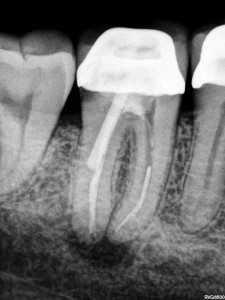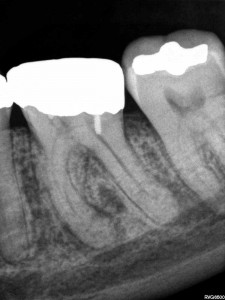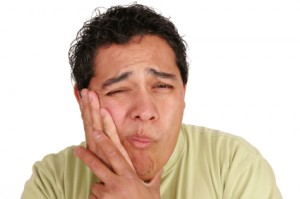
Poorly Prepared, Obturated and Missed Canals All Contribute to Persistent Apical Periodontitis
Persistent Apical Periodontitis (AP) refers to AP that is associated with a tooth that has had root canal therapy (RCT). As with primary AP, bacteria are the most common cause of the inflammatory response (Sudqvist et al. 1998). Previously there has been a large body of evidence that persistent infections are commonly composed of a single species, however recent evidence points to the presence of a mixed biofilm (Siqueira et al. 2009a, Chavez de Paz 2007).”]
There are also non microbial causes of AP, including foreign body reactions, cystic formation, endogenous cholesterol crystals and scar formation. These will be discussed later.
The microbes that cause persistent AP are more commonly located intraradicularly (inside the root). Occasionally, these microbes will also be located extraradicularly. We’ll discuss the far more common intraradicular microbes first.
Intraradicular Microbes
The key study for referencing the presence of microbes within the root in cases of persistent AP is Nair et al. 1990a. When considering the cause of the persistent infection, consider that the microbes were either present prior to RCT being initiated (primary infection ) or they entered during or after treatment (secondary infection) (Siquiera 2008). When thinking about those microbes that have survived from the primary infection, consider how they might have achieved this. They may have been resistant to the chemicals used in the disinfection process (e. feacalis for example has some mechanisms to survive calcium hydroxide), or they may have been located in a portion of the canal that was not instruments nor cleaned via chemical means.
When considering the secondary infection, these microbes may have gained access to the canal during treatment or after treatment. Think about this also. They may have been carried into the canal on a contaminated instrument or perhaps a leaking rubber dam may have allowed saliva to contaminate the root canal. Alternatively, a poorly placed temporary restoration may have allowed leakage into the root canal system in between visits. If caries have not been completely removed, or a previous restoration which is subject to microleakage is left in place, then this can also be a source of secondary infection. Alternatively, these microbes may have entered a previously clean root canal system after the completion of RCT. This could be due to a leaking restoration, or through caries or a crack in the tooth. It’s important to understand the microbial nature of AP, and to have this foremost in our minds when undertaking treatment.
Which microbes are present in secondary in persistent AP?
When we look at the composition of the infection in AP, we find a significantly different microflora than that found in primary infections (Figdor et al. 2007, Molander et al. 1998). Generally in persistent AP, there are only 1-5 species. These are predominantly gram-positive and there is an equal amount of obligate and facultative anaerobes. (Figdor et al. 2007, Sundqvist et al. 1998, Siqueira et al. 2009b). Due to the fact that obligate anaerobes are easier to kill, it may be that facultative anaerobes are more likely to persist within the root canal system after treatment.
E. Faecalis & c.albicans
Enterococcus faecalis is an opportunist pathogen which is implicated in many general surgery post-operative infections. It has been identified as an opportunistic pathogen in persistent AP in a number of studies (Sundqvist et al. 1998, Sundqvist et al. 2003, Molander et al. 1998). This particular microbe has been studies extensively. It possesses a “proton pump” on its cell membrane which allows it to regulate its internal pH. This means that it is resistant to calcium hydroxide and this may be one of the ways that it survives and becomes implicated in persistent infections. It is also able to survive by itself and without nutrition for long periods of time. It is rarely found in untreated canals. Candida albicans (a fungus) is also found more commonly in persistent infections than in primary infections. (Sundqvist et al. 1998, Nair et al. 1990a, Waltimo et al. 2004)
Extraradicular Infections
Occasionally, we may find a situation where microbes establish themselves outside the root canal system. The microbes may establish themselves on the external root surface in a biofilm, in association with infected dentine chips that have been displaced into the periapical region, or within a periapical cyst (Abbott 2004, Nair 2008). These microbes must be able to withstand the body’s attempts to kill them and it is likely that biofilm formation allows this (Noiri et al. 2002). Similarly in the periapical cyst situation, it is the cyst itself that protects the microbe from the immune response.
In particular, two microbes have been implicated in extraradicular infections. These are Actonomyces spp. And Proprionibacterium proprionicus (Siqueira 2002). These microbes are able to form cohesive colonies within an extracellular matrix. This helps them to avoid phagocytosis, and so continue to survive and invoke the immune response.
Non-microbial causes of AP – Cysts, Foreign Body Reactions and Cholesterol Crystals
In some cases, AP may not be “maintained” by microorganisms. I say “maintained”, because often the AP is initially caused by microbes, and after endodontic treatment, one of the following factors takes over, maintaining the immune response and thus, AP.
Periapical cysts are an interesting topic. There are a range of studies that attempt to measure the incidence of periapical cysts in examined PA lesions. In simple terms, the lesion is biopsied and then examined under a microscope. If an epithelium lined sack is found, then the lesion is designated a cyst. But…… In 1980 Simon published a paper which included serial sectioning of periapical lesions (Simon, 1980). What he found was that some lesions that appeared as cysts on one section, appeared differently on other sections. Thus, it was deemed that the majority of studies (which don’t use serial sectioning) relating to the prevalence of cysts were subject to error. If you just take a random slice, the effect in two dimensions may be that of a cyst, when in reality the full three dimensional structure of the cyst does not exist. Nair repeated this study 16 years later and confirmed Simon’s findings (Nair, 1996).
Nair studied far more lesions than Simon, and found that 15% could be classified as cysts (including both true and pocket varieties). This is probably the best figure to be quoting. Other studies report figures from 5-55%, but they failed to use serial sections. It is also important to realize that a great number a large proportion of abcesses and granulomas will also contain epithelium. In Nair’s study, 52% of the lesions were epithelialised, but only 15% were cysts. It is likely that the inflammatory process results in the proliferation of this epithelium, and over time, the epithelium develops into a cyst.
Through both of these studies, Simon and Nair found two distinct types of cysts. Simon called them true cysts, those with a complete epithelial lining, and bay cysts, those whereby the lining is attached to the root surface and the contents of the root canal contiguous with the contents of the cyst. Nair referred to these as true cysts and pocket cysts (equivalent to Simon’s Bay cyst).
Nair contends that these two types of cysts are quite different (Nair 2008). He feels that the true cyst is self sustaining, and will remain independent of efforts to remove the microorganisms from the root canal system. The pocket cyst, on the other hand is being sustained by the microbes within the canal system. Removal of the microbes which are maintaining the inflammatory response may allow the pocket cyst to heal. In reality, it will be very difficult to prove or disprove this theory, but one could say that it makes sense.
Foreign body reactions
When exogenous materials are located in the periapical region, they can induce and maintain an inflammatory response which may be asymptomatic, but will be seen as a radiolucency. Materials may be GP, amalgam, sealants, Calcium hydroxide or cellulose fibres such as those contained in paper points (Nair et al. 1990b).
In practice these lesions are rarely seen but have been reported in the literature, so it is important to understand that this mechanism for the maintenance of AP does exist. It also reminds us to be careful when using paper points not to extend them into the periapical areas, as human cells cannot degrade cellulose and leaving fibres behind may result in a foreign body reaction.
Gutta percha may also induce a foreign body reaction, especially in fine particles (Sjögren et al. 1995). Overextended GP may, as a result cause delayed healing of periapical tissues.
Cholesterol Crystals
Cholesterol crystals are also seen in AP, and are probably released by disintegrating erythrocytes, lymphocytes, macrophages, plasma cells and from circulating plasma lipids (Nair 1999). These collections of cholesterol are referred to as cholesterol clefts and induce a reaction similar to a foreign body reaction as the macrophages and giant cells are unable to remove the cholesterol. Again, this may result in a non-healing lesion, despite well completed endodontic treatment.
The Endospot Easy Study Guide to Persistent AP
- Persistent AP is most commonly caused by microbes remaining within the root canal system (sundqvist et al. 1998)
- It appears that a mixed biofilm may be responsible, contrary to the previous belief that usually only one microbe was responsible. (Chavez de Paz 2007)
- The microbes are either (Siquiera 2008):
- Primary – remained within the canal from the initial infection
- Secondary – entered during or after treatment
- Significantly different flora to primary AP (Molander et al. 1998)
- 1-5 species per canal
- predominantly gram positive
- equal number of obligate and facultative anaerobes
- E. faecalis – opportunist pathogen which has been identified more commonly in persistent AP (Sundqvist 1998)
- Posesses a “proton pump” which allows it to survive in high pH (i.e. can survive calcium hydroxide)
- Can survive in mono-infection
- can survive long periods of low/no nutrition
- Candida Albicans also found more commonly in persistent infections than in primary (Waltimo et al. 2004)
- Exraradicular infections can occur in biofilm on the root tip (Noiri 2002), or in the PA area itself (Siquiera 2002)
- Proprionibactrium proprionicus and Acinomyces species are able to from adhesive colonies in an extracellular matrix in the PA tissues
- Non-microbial causes of AP are:
- Periapical cysts – 15% of lesions (Nair 1996)
- Serial sectioning indicates two types – true cysts and pocket cysts
- Foreign Body Reactions
- Cholesterol Clefts
References:
ABBOTT, P. V. 2004. Classification, diagnosis and clinical manifestations of apical periodontitis. Endodontic Topics, 30-54.
CHAVEZ DE PAZ, L. E. 2007. Redefining the persistent infection in root canals: possible role of biofilm communities. J Endod, 33, 652-62.
FIGDOR, D. & SUNDQVIST, G. 2007. A big role for the very small–Understanding the endodontic microbial flora. Australian Dental Journal, 52, 38.
MOLANDER, A., REIT, C., DAHLEN, G. & KVIST, T. 1998. Microbiological status of root-filled teeth with apical periodontitis. Int Endod J, 31, 1-7.
NAIR, P. N., SJÖGREN, U., KREY, G., KAHNBERG, K. E. & SUNDQVIST, G. 1990a. Intraradicular bacteria and fungi in rootfilled, asymptomatic human teeth with therapy-resistant periapical lesions: a long-term light and electron microscopic follow-up study. J Endod, 16, 580-8.
NAIR, P. N., SJÖGREN, U., KREY, G. & SUNDQVIST, G. 1990b. Therapy-resistant foreign body giant cell granuloma at the periapex of a root-filled human tooth. J Endod, 16, 589-95.
NAIR, P. N. 1996. Types and incidence of human periapical lesions obtained with extracted teeth. Oral Surg Oral Med Oral Pathol Oral Radiol Endod, 81, 93-102.
NAIR, P. N. 1999. Cholesterol as an aetiological agent in endodontic failures–a review. Aust Endod J, 25, 19-26.
NAIR, P. N. 2008. Pathobiology of Apical Periodontitis. Essential Endodontology. 2nd ed. Oxford: Blackwell Munksgaard.
NOIRI, Y., EHARA, A., KAWAHARA, T., TAKEMURA, N. & EBISU, S. 2002. Participation of bacterial biofilms in refractory and chronic periapical periodontitis. J Endod, 28, 679-83.
SIMON, J. H. S. 1980. Incidence of periapical cysts in relation to root canal. J Endod, 6, 845-8.
SIQUEIRA, J. F. 2002. Endodontic infections: concepts, paradigms, and perspectives. Oral Surg Oral Med Oral Pathol Oral Radiol Endod, 94, 281-93.
SIQUEIRA, J. 2008. Microbiology of Apical Periodontitis. Essential Endodontology. Oxford: Blackwell Munksgaard.
SIQUEIRA, J. F., JR. & ROCAS, I. N. 2009a. Community as the unit of pathogenicity: an emerging concept as to the microbial pathogenesis of apical periodontitis. Oral Surg Oral Med Oral Pathol Oral Radiol Endod, 107, 870-8.
SIQUEIRA, J. F. & RÔÇAS, I. N. 2009b. Diversity of endodontic microbiota revisited. Journal of Dental Research, 88, 969-81.
SJÖGREN, U., SUNDQVIST, G. & NAIR, P. N. 1995. Tissue reaction to gutta-percha particles of various sizes when implanted subcutaneously in guinea pigs. European Journal of Oral Sciences, 103, 313-21.
SUNDQVIST, G. & FIGDOR, D. 2003. Life as an endodontic pathogen. Endodontic Topics, 6, 3-28.
SUNDQVIST, G., FIGDOR, D., PERSSON, S. & SJÖGREN, U. 1998. Microbiologic analysis of teeth with failed endodontic treatment and the outcome of conservative re-treatment. Oral Surg Oral Med Oral Pathol Oral Radiol Endod, 85, 86-93.
WALTIMO, T. M. T., HAAPASALO, M., ZEHNDER, M. & MEYER, J. 2004. Clinical aspects related to endodontic yeast infections. Endodontic Topics, 66-78.























